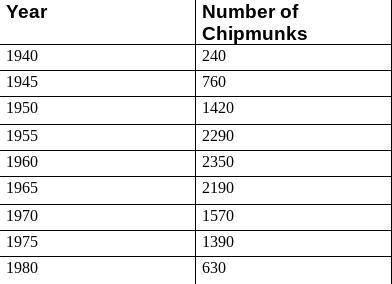
A group of wildlife biologists studied a chipmunk population in a 3000 hectare forest from 1940 to 1995. Estimates of the size of the population (rounded off to the nearest to) are shown in the table below
a. Graph the change in size of the population from 1940 to 1995.
b. What was the population density of chipmunks in 1970?
c. What was the average change in the population density from 1940 to 1960?
d. What was the average change in population from 1960 to 1985?
e. A biologist thinks the population of chipmunks will be in the range of 2900 to 3100 in the year 2000. Is that a reasonable guess? Why or why not?



Answers: 2
Another question on Biology

Biology, 21.06.2019 17:00
Mike was adopted, and his biological family history is unknown. although he is healthy, he would like some understanding of his genetic makeup, including potential health risks and genes that he could pass on to his children. mike has heard about commercial laboratories that can compare segments of your dna to those of people with common hereditary diseases in order to give you some idea of how susceptible you are to the diseases. the results of these types of tests are highly inconclusive. if mike's dna showed that he shares similarities in a segment of dna with people who have a given disease, his chances of developing that disease or passing it on to his children may be slightly elevated, but they are not 100 percent. these tests can cost more than $2,500 and are not covered by many insurance companies. do you think that mike should undergo the genetic tests? explain your answer. what are the potential pros and cons of having such tests done? describe how the availability of these genetic tests might affect the frequency of genetic diseases in individuals and populations.
Answers: 1

Biology, 22.06.2019 13:20
Imagine a self-reactive t cell that has not undergone clonal deletion in the thymus (that is to say, it has escaped central tolerance). if it encounters self antigen in the absence of an infection or inflammation, what will happen to this self-reactive t cell? (select two answers) (a) the t cell undergoes clonal expansion. (b) the t cell gains effector functions. (c) the t cell undergoes apoptosis. (d) the t cell becomes activated. (e) the t cell becomes anergic.
Answers: 1


Biology, 22.06.2019 16:30
The offspring of a black cat and a white cat is a gray cat, it has the genotype bw if a black cat mates with a gray cat the chance that the offspring is white will be what percent?
Answers: 1
You know the right answer?
A group of wildlife biologists studied a chipmunk population in a 3000 hectare forest from 1940 to 1...
Questions

Biology, 20.07.2019 10:30

History, 20.07.2019 10:30

Mathematics, 20.07.2019 10:30

Social Studies, 20.07.2019 10:30

Advanced Placement (AP), 20.07.2019 10:30

Social Studies, 20.07.2019 10:30

Mathematics, 20.07.2019 10:30

Biology, 20.07.2019 10:30

Chemistry, 20.07.2019 10:30

Biology, 20.07.2019 10:30

Social Studies, 20.07.2019 10:30


Mathematics, 20.07.2019 10:30

Mathematics, 20.07.2019 10:30


Biology, 20.07.2019 10:30


Spanish, 20.07.2019 10:30

Biology, 20.07.2019 10:30



